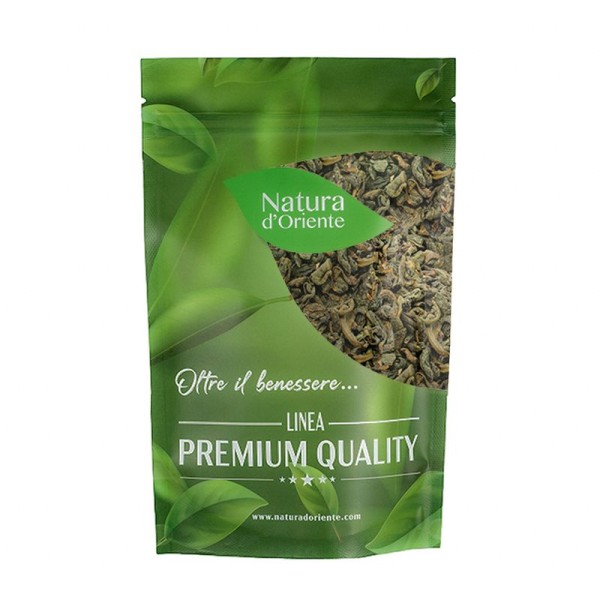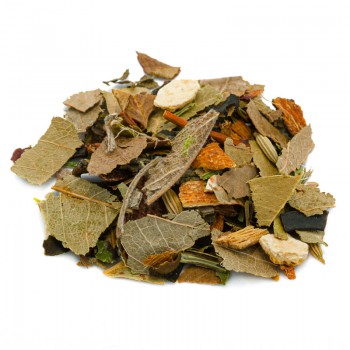Gunpowder green tea
This infusion takes its name from its appearance and taste. The method of preparation makes it special given that the leaves are first rolled up and reduced as if they were "grains" of gunpowder; later, they open up in the infusion and release their taste.
The tea has a smooth and sweet taste that for some is slightly smoky, earthy sometimes even metallic. The color is slightly more yellow than other green teas.
Properties and benefits
There are several varieties of gunpowder green tea commercially available, but most appear to provide similar benefits to the body, due in large part to the polyphenolic compounds, catechins and alkaloids in the leaves . The benefits of drinking green tea in its Gunpowder version include both the benefits of green tea in general and those related to its high theine (caffeine) content. While classic green tea contains about 30 mg of theine per cup, Gunpowder tea often provides more (about 50 mg and depends on the brew).
Gunpowder is considered a good tea for stimulating metabolism, aiding weight loss, and increasing body energy. Several elements combine in this tea to increase the body's ability to burn fat by speeding up the metabolism. Theine, catechins and theanine are able to trigger processes of thermogenesis: the body generates heat and increases the metabolism, burning extra calories. Especially among green tea catechins, EGCG (Epigallocatechin gallate) is one of the most beneficial components of green tea with thermogenic properties; helps to increase metabolic activity and release energy. Furthermore, in theine it seems that there are also qualities useful for reducing appetite and avoiding harmful overeating.
Thanks to the high theine / caffeine content in the tea leaves, gunpowder is an alternative for those who wish to avoid the acidity of coffee, while maintaining caffeine's ability to improve concentration and alertness.
This tea can help with digestive problems, thanks to the catechins. These substances can have an effect on inflammation in the intestines and other parts of the body. For those suffering from irritable bowel, constipation, bloating, cramping or other inflammatory conditions in the stomach, a cup of green tea helps digestive transit and soothes ailments. For centuries it has been considered a natural remedy to soothe inflammatory pains (arthritis), and is useful as a drainer of excess fluids.
Like many green teas, Gunpowder is also rich in antioxidants. Active compounds can help neutralize free radicals and reduce oxidative stress. The polyphenols in Gunpowder green tea may have a positive impact on the immune system as well. Some studies have long focused on the possible beneficial properties for the heart, thanks to the action of antioxidants on harmful cholesterol. Gunpowder green tea antioxidants are useful for a good skin appearance, having valid anti-aging properties and against the effect of free radicals that damage cells over time. Furthermore, these compounds have made green tea valid in popular medicine for the well-being of the oral cavity, against tooth decay.
Origins and History of cultivation
Gunpowder green tea is a particular variety of the Camellia sinensis plant. It is from this plant that tea is obtained, and precisely from the leaves. Compared to the classic tea, the Gunpowder variety comes from a different preparation, originating in the province of Zhejiang, on the east coast of China. The leaves are rolled into small compressed grains, resembling the old-fashioned gunpowder grains, from which the tea gets its name. It was originally called pearl tea based on the shape of each small grain.
Its history begins in the Chinese territory during the Tang Dynasty (618 - 907 AD), when this tea was first produced. The name Gunpowder probably derives from a discovery in the 18th century by a Briton. Because of its resemblance to gunpowder pellets, he nicknamed it that. It was the British sailors who brought this tea from China to the West. Some specify its origin, calling it Chinese Gunpowder tea. To create the highest quality gunpowder, the leaves are dried to remove moisture, then steamed, then rolled and dried. All very carefully so as not to break the leaf. This process allows the leaves to retain much more nutrients, including a slightly higher level of theine than other green teas. It is a long preparationand some high-quality Gunpowder teas can be stored for about a decade, without losing their potency or flavor. The moment this variety is placed in the cup of tea, every single leaf unrolls, according to some it even “explodes” in taste.
Infusion enthusiasts mix it with other types of tea or infusions to create a unique flavor. For example in North Africa they combine it with mint, creating the so-called Moroccan mint tea. To date, Gunpowder tea is produced in the original province of Zhejiang, but also in the Chinese provinces of Guangdong, Anhui, Hunan and Fujian. We can also find it outside of China, and depending on the type of leaves used, different types of Gunpowder Green Tea can be tasted. Some pickers use the bud and first small leaves of the plant, while others pick the largest, most mature tea leaves.
Plant and flowers
Green tea comes from the Camellia Sinensis plant, native to East Asia and belonging to the Theaceae family. This plant represents a genus that includes about 250 species of trees and shrubs evergreen, slow growing. Shows leathery leaves, glossy dark green, lanceolate and toothed depending on the variety. Sometimes called Thea sinensis, the Camellia can reach 9 meters in height, but is usually grown reduced to a low bush, often pruned to encourage the development of the young tea leaves.
The flowers are fragrant, white and about 4 cm wide. They are adorned with golden-yellow stamens, and appear in autumn and early winter. Camellia sinensis is probably the most cultivated camellia in the world, used to obtain teas with theine. The leaves are harvested in early spring and processed in different ways. The smaller young leaves and buds are used for making green tea, the larger leaves for oolong and black tea, and the buds for making white tea.
Nutritional values Gunpowder green tea
Green tea contains high amounts of polyphenol antioxidants, including the important EGCG - Epigallocatechin gallate. Donates phytochemicals known as methylxanthines (caffeine / theine, theobromine, theophylline) Makes vitamin C and B vitamins (thiamin, riboflavin, niacin) available to our body. Contains minerals such as iron, magnesium, potassium, zinc.
How to prepare Gunpowder Green Tea
The infusion is obtained by placing about 3-5 grams of rolled green tea leaves in a cup (250 ml) with water at 80 °C. Let it steep for 2 to 3 minutes before drinking the gunpowder. Add honey or sugar, if desired.
Gunpowder green tea: side effects and contraindications
Green tea can cause side effects if the recommended doses are not respected – since the theine / caffeine content can create consequences. Drinking too much green tea can increase your risk of developing kidney stones, and it can be harmful to your nervous system.
It is possible that a high dose of green tea can induce anxiety, agitation, insomnia, rapid heartbeat and high blood pressure.
Furthermore, green tea could affect the functioning of the thyroid gland, or cause liver fatigue. For this reason, it is advisable to consult a specialist in case of chronic pathologies. Caution is advised on amounts of green tea for pregnant and lactating women.









 No reward points for this product.
No reward points for this product.








